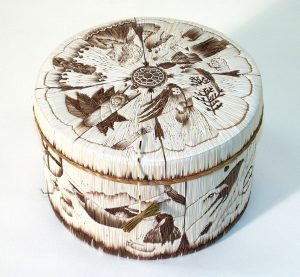The first major traveling exhibition featuring Anishinabe porcupine quill art is now on view at the Ziibiwing Center, Mount Pleasant, MI (Saginaw Chippewa Indian Tribe of Michigan). The exhibition showcases over 90 works drawn from private and public sources, including selections from the MSU Museum’s collection. This exhibition, led by Minnie Wabanimkee, a tribal elder and photographer, and Dr. Marsha MacDowell, MSU Museum’s Folk Arts Curator, is the result of collaboration among museum curators, MSU faculty and staff, and Native artists and elders.

Titled Gaawii Eta-Go Aawizinoo Gaawiye Mkakoons / It’s Not Just a Quill Box / Anishinaabe Gaak Gaawiiyikewin Zhichiganan / Anishinabek Porcupine Quill Art, this exhibition is the first of its kind to be fully bilingual, featuring both Anishinabemowin and English. The exhibition has been curated with the guidance of a committee of Native artists and elders, ensuring the authenticity and cultural integrity of the work on display.
As part of the curatorial team, Dr. C. Kurt Dewhurst, Curator of Folklife and Cultural Heritage at the MSU Museum remarked, “The pieces in this exhibition honor the resilience of Indigenous communities. They remind us of the generations who have kept these traditions alive, often in the face of great adversity, and celebrate the vibrant future of Anishinabe artistry.”
This exhibition focuses on the artwork of contemporary Anishinabe artists from Michigan, Wisconsin, Minnesota, and Manitoulin Island, Canada, while honoring the generations of ancestors who have passed down the knowledge and skills required to master this unique art form. The exhibition highlights the intricate relationships between teachers and learners, the deep connection between the art and natural resources, and the challenges of preserving this tradition in the modern world.
In addition to the art, visitors can expect to see videos and images showcasing the harvesting of materials and the quill art creation process. Interactive panels, hands-on activities, and a recreation of a master artist’s workstation provide an immersive experience for all audiences.
“The MSU Museum is honored to collaborate on this exhibition where past meets present to amplify Indigenous voices and share knowledge of their artistic traditions,” said Devon Akmon, Director of the MSU Museum. “The Museum’s collection is a great resource for creating connections and bringing awareness to cultural diversity.”
The exhibition is on view at the Ziibiwing Center through March 15, 2025 before traveling to four additional venues. A special celebratory program is planned for December 6, 2024, from 1:00 – 3:00 p.m. at the Ziibiwing Center.
This project was led by the collaborative efforts of the Ziibiwing Center for Anishinabe Culture and Lifeways; the Michigan Traditional Arts Program and MSU Office of University Outreach and Engagement; and the Michigan State University Museum. The project has been made possible through support from the Terra Foundation for American Art, National Endowment for the Arts, Institute of Museum and Library Services, The Andrew W. Mellon/Less Commonly Taught Language Grant at Michigan State University, Michigan Traditional Arts Exhibition Fund/MSU with additional in-kind support from the Ziibiwing Center of Anishinabe Culture and Lifeways (Saginaw Chippewa Indian Tribe of Michigan), Michigan State University Museum, Eyaawing Museum and Cultural Center (Grand Traverse Band of Ottawa and Chippewa Indians), Ojibwe Cultural Foundation (Manitoulin Island, Canada), Northwest Michigan Arts & Culture Network, Michigan Traditional Arts Program/MSU, Michigan State University Native American Institute, and the MSU Office for University Outreach and Engagement.
Image Caption:
Nji-sa ndoweminaanik/ To Our Sisters
Yvonne Walker Keshick (Little Traverse Bay Bands of Odawa Indians)
Harbor Springs, Michigan
Michigan State Gchi-kinoomaagegamik, Michigan Naadiziiwin gegoo Zhichigannokiiwin/ Michigan State University Museum, Michigan Traditional Arts ProgramCollection 7594.20